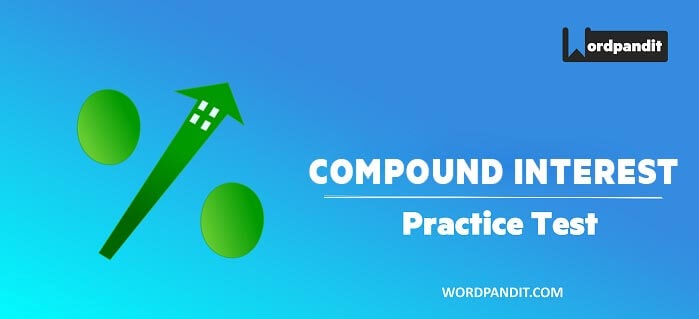- This is an assessment test.
- To draw maximum benefit, study the concepts for the topic concerned.
- Kindly take the tests in this series with a pre-defined schedule.
Arithmetic: Compound Interest Test -5
Congratulations - you have completed Arithmetic: Compound Interest Test -5.You scored %%SCORE%% out of %%TOTAL%%.You correct answer percentage: %%PERCENTAGE%% .Your performance has been rated as %%RATING%%
Your answers are highlighted below.
Question 1 |
Rs. 5887 is divided between Shyam and Ram, such that Shyam's share at the end of 9 yr is equal to Ram's share at the end of 11 yr, compounded annually at the rate of 5%. The share of Shyam is?
Rs 2088 | |
Rs 2000 | |
Rs 3087 | |
Data inadequate |
Question 1 Explanation:
let Shyam’s share = S
Then S[ 1+5/100]9 = (5887- S)[1+5/100]11
=> S/ (5887 – S) = 1.1025
=> S = Rs 3087
Then S[ 1+5/100]9 = (5887- S)[1+5/100]11
=> S/ (5887 – S) = 1.1025
=> S = Rs 3087
Question 2 |
Meera takes a loan of Rs. 10000 and pays back Rs. 13310 after 3 years .The compound interest rate per annum will be approximately?
8% | |
9% | |
10% | |
11% |
Question 2 Explanation:
Let r% be the compound interest
Then 10000 x (1+ r/100)3 = 13310
(1+ r/100)3 = 1331/1000
1+ r/100) = 11/10
r/100 = 1/10
r = 10%
Then 10000 x (1+ r/100)3 = 13310
(1+ r/100)3 = 1331/1000
1+ r/100) = 11/10
r/100 = 1/10
r = 10%
Question 3 |
A sum of money is accumulating at compound interest at a certain rate of interest. If simple interest instead of compound were reckoned, the interest for first two years would be diminished by Rs 20 and that for the first three years by 61. Find the sum.
Rs 7000 | |
Rs 47405 | |
Rs 45305 | |
Rs 8000 |
Question 3 Explanation:
Let P be the principal and r be the rate percent.
The difference between compound interest and simple interest for a certain rate of interest r
and duration of two years is given by the formula: P (r/100)2
If there is difference between the simple interest and
compound interest for two years then the principle will be = 20 x (100)2/r2 .....................................1
The difference between compound interest and simple interest for a certain rate of interest r
and duration of three years is given by the formula: P {r2(300+r)/(100)3}
If there is difference between the simple interest and compound interest for three years
then the principle will be = 61 x (100)3/r2(300+r)...........................2
Equating 1 and 2:
20 x (10)4/r2 = 61 x (100)6/r2(300+r)
r = 305 – 300 =5%
From 1
P= {20 x (10)4}/25
= Rs. 8000
The difference between compound interest and simple interest for a certain rate of interest r
and duration of two years is given by the formula: P (r/100)2
If there is difference between the simple interest and
compound interest for two years then the principle will be = 20 x (100)2/r2 .....................................1
The difference between compound interest and simple interest for a certain rate of interest r
and duration of three years is given by the formula: P {r2(300+r)/(100)3}
If there is difference between the simple interest and compound interest for three years
then the principle will be = 61 x (100)3/r2(300+r)...........................2
Equating 1 and 2:
20 x (10)4/r2 = 61 x (100)6/r2(300+r)
r = 305 – 300 =5%
From 1
P= {20 x (10)4}/25
= Rs. 8000
Question 4 |
The difference between the compound interest and the simple interest compounded annually at the rate of 12% per annum on Rs. 5000 for two years will be:
Rs 17.50 | |
Rs 36 | |
Rs 45 | |
Rs 72 |
Question 4 Explanation:
Here again If there is difference between the simple interest and compound interest for two years then the principle will be
Simple interest for two years
= (p x r x t )/100
= (5000 x 12 x 2)/100
= 1200
Compound Interest for two years = 5000[(1+12/100)2 -5000]
So the difference between both is:
= 5000[(1+12/100)2 -5000] – 1200
= [5000{(28/25 x 28/25) – 1} -1200]
= [5000{(784 - 625) /625}-1200] =Rs. 72
Simple interest for two years
= (p x r x t )/100
= (5000 x 12 x 2)/100
= 1200
Compound Interest for two years = 5000[(1+12/100)2 -5000]
So the difference between both is:
= 5000[(1+12/100)2 -5000] – 1200
= [5000{(28/25 x 28/25) – 1} -1200]
= [5000{(784 - 625) /625}-1200] =Rs. 72
Question 5 |
A sum of money becomes 8 times in 3 years, if the rate is compounded annually. In how much time the same amount at the same compound interest rate will become 16 times?
4 | |
6 | |
2 | |
9 |
Question 5 Explanation:
Let the total money be M
Then 8M = M(1+r/100)3
(1+r/100)3 = 23
(1+r/100) = 2 ................ (1)
Again let the sum will become 16 times in p years then
16M = M(1+r/100)P
16 = 2P...................................... from (1)
24 = 2P
p= 4 years
Then 8M = M(1+r/100)3
(1+r/100)3 = 23
(1+r/100) = 2 ................ (1)
Again let the sum will become 16 times in p years then
16M = M(1+r/100)P
16 = 2P...................................... from (1)
24 = 2P
p= 4 years
Once you are finished, click the button below. Any items you have not completed will be marked incorrect.
There are 5 questions to complete.
List |











